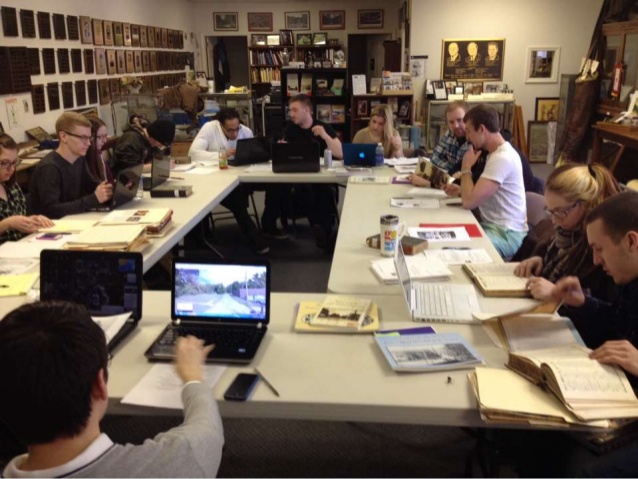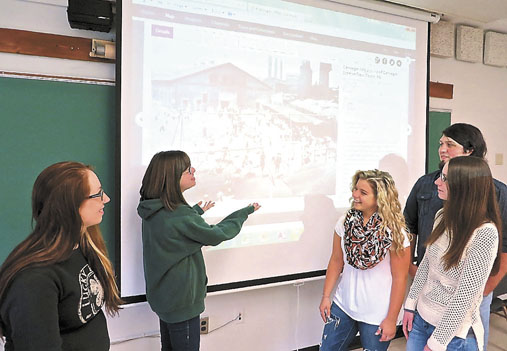After seeing a tweet about how students at Slippery Rock University teamed up with Lawrence County Historical Society to add some amazing content to Historypin, we asked Dr. Aaron Cowan to tell us more. Dr. Cowan is a historian and assistant professor of History at this mid-sized state university in western Pennsylvania, where he teaches modern US, urban, and public history.
Why did you choose Historypin for this particular project?
The Historypin project was a part of my Introduction to Public History undergraduate course; the class partnered with the Lawrence County Historical Society (LCHS) in nearby New Castle, PA to select, research, and upload historical images to Historypin. Students worked in groups of 3, with each group member performing specific roles
Historypin seemed like the ideal platform to allow undergraduates to understand the potential of digital history, and create a presentable public history project, without the technology “getting in the way” – within the confines of a 15-week academic term, they needed to focus on historical research, not learning the intricacies of Javascript or how to work with GoogleEarth databases. I’m also fascinated by the potential for location-based digital history for increasing community engagement, so again – Historypin was a great fit!

What were some of the things that worked well?
The project was great for teaching students research skills; even some of our History majors found local history research to be a new challenge – rather different than writing a standard term paper where they could pull some books and journal articles from the library and synthesize those into an essay. One advantage we had is that the city’s main newspaper has been digitized and available through NewspaperArchive; keyword searching is a wonderful thing! Hard to believe students may never know the tedious experience of scrolling through microfilm…
Students took a good deal of ownership with the project; they were very enthusiastic about the fact that their research was going to be publicly presented & not simply submitted to the professor. Reflecting on the project, one student commented, “For the first time in my four years as a history major, I felt like a historian and not just a history student.”
Another reflected, “The Historypin project was my favorite project I have ever completed in college because it showed me just how much work a public historian truly does. Public historians conduct a great deal of research, which is not always easy. Sometimes, they must do some digging to find that missing element that brings the whole project together…the experience also showed our group just how much collaboration needs to be done for the end result to be successful.”
What didn’t work well, or what would you change if you did this again?
In the future, I’ll allow more time for the students’ research – several simply underestimated the difficulty of the research, and hit roadblocks. I’ll also spend more time educating them on resources for local history (city directories, insurance maps, etc.) and connecting them to the local history/genealogy staff at the city library. On a related note, I would probably assign fewer images (initially, each student was assigned 5) to allow them more time.
Do you think this is a replicable model? It seems like there are so many small historical societies and the like that we could help get online…
I think it’s very replicable; my hope is to continue the project each year – either with this historical society or others in the area. One advantage for this project is that the LCHS had already digitized their entire collection, so students didn’t have to sift through disorganized prints and then worry about proper scanning resolution, format, size, etc. – though of course a project involving those tasks would also teach valuable skills!
LCHS, like most of the county historical societies in our area, is understaffed and underfunded, even though their historical resources are amazing. They need to create greater community investment and engagement, and to connect with younger audiences. Hopefully the Historypin project provides a way for them to begin doing just that.
Clear guidelines and expectations are essential (and I’d be happy to share mine – anyone interested can email me at aaron.cowan@sru.edu).
What were some favorite/interesting pieces of content that came from the project?
The photo of a 1925 KKK picnic in the city’s park caused quite a stir among the students; New Castle – and western Pennsylvania generally – had a strong contingent of the 1920s Klan because of nativist fears of Catholic “new immigrants” drawn to jobs in the region’s steel and ancillary industries. Another unusual find was a photo of a 1976 bank robbery in progress (pulled from bank security cameras).
On a lighter note, a 1912 photo circus parade of elephants marching through downtown was a fun addition.
Were there any surprise social outcomes of this?
I had hoped social connections between community residents and students would be a more prominent part of the project, but it did not materialize. I think in part this is attributable to students’ hesitancy to use methods like interviews to conduct their research, in favor of online or library research. It might have been strengthened if the project had directly involved the community in some sort of workshop or public forum.
I was proud of the fact that this project brought attention to some stories – in this case, particularly African-American history – that don’t always get a lot of attention in the “official” local histories.

What kinds of history mysteries keep you up at night/wake you up in the morning?
I don’t know if specific mysteries come to mind, but I’m constantly surprised by the layers and complexity of local history – that even in small towns where everyone assumes “nothing happened” there are stories of conflict, activism, and linkages to the broader current of national and world history. I’m very much motivated by fragments of evidence that hint at holes – what historian Michel-Rolph Trouillot has called “silences” – in the popular narrative of local history; these kinds of stories can often be empowering for people, or provide a model for a path forward to a better future. To me, that’s the real purpose of history.